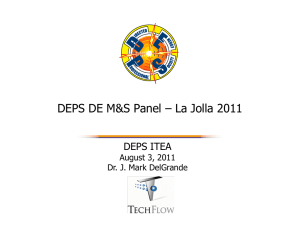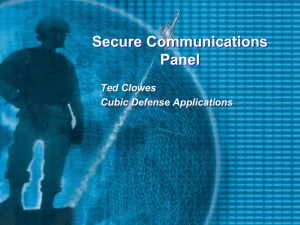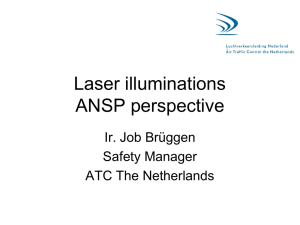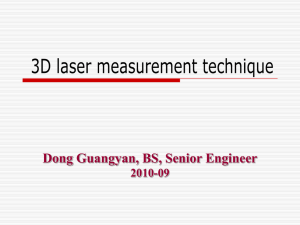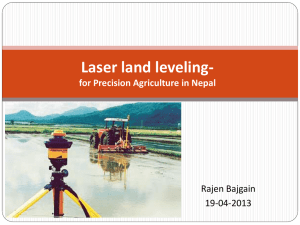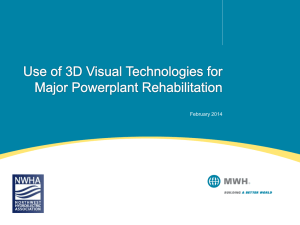AIAA Directed Energy Systems Program Committee
advertisement
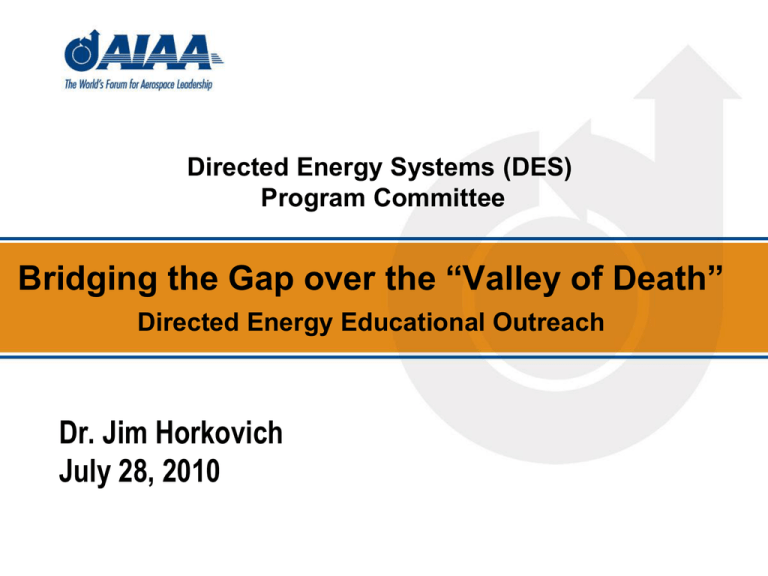
Directed Energy Systems (DES) Program Committee Bridging the Gap over the “Valley of Death” Directed Energy Educational Outreach Dr. Jim Horkovich July 28, 2010 Agenda • • • • • • White House S&T Policy Aerospace Industry Corporate R&D in Decline Acquisition “Valley of Death” Directed Energy (DE) Outreach Public Policy Issues Proposed Scope and Events 2 S&T Policy Statement for FY2011 Budget 3 S&T Policy Statement for FY2011 Budget Four practical challenges: • Applying S&T strategies to drive economic recovery, job creation, and economic growth; • Promoting innovative energy technologies to reduce dependence on energy imports and mitigate the impact of climate-change while creating green jobs and new businesses; • Applying biomedical science and information technology to help Americans live longer, healthier lives while reducing health care costs; and • Assuring we have the technologies needed to protect our troops, citizens, and national interests, including those needed to verify arms control and nonproliferation agreements essential to our security. 4 S&T Policy Statement for FY2011 Budget Addressing these challenges will require: • Increasing productivity our research universities and major public and private labs and research centers; • Strengthening STEM education at every level, from precollege to post-graduate to lifelong learning; • Improving and protecting our information, communication, and transportation infrastructure; • Enhancing our capabilities in space, essential for communications, geopositioning, intelligence gathering, Earth observation, and national defense, as well for increasing our understanding of the universe and our place in it. 5 S&T Policy Statement for FY2011 Budget Develop outcome-oriented goals in relation to these four practical challenges • Explain how agencies are strengthening their capacity to rigorously evaluate success of their programs. • Open innovation model, in which the whole chain from research to application does not have to take place within a single lab, agency or firm, • Support for long-term, visionary thinkers proposing high-risk, high-payoff research. • Explain how S&T investments contribute to increased economic productivity and progress - make these data open to the public in accessible, useful formats. • Develop “science of science policy” tools that can improve management. 6 2011 DoD S&T Budgets • Basic Research (6.1): $1.99B, a 7.8% decline from $2.16B appropriated in FY 2010 • Applied Research (6.2): $4.47B, a 10.6% decline from $5.0B appropriated in FY 2010 • Advanced Technology Development (6.3): $5.35B, an 18.2% decrease from the $6.54B enacted by Congress in FY 2010. $2 billion gap between what Congress appropriated in FY-10 and what DOD is seeking in FY-11 7 Decline in Aerospace Corporate R&D • Funded and Corporate R&D declining putting future leadership in innovation at risk • Average Industry R&D Investment has declined from 2.86% of revenues in 2006 to 2.67% in 2008. • Small apparent percentage represents a large amount of dollars. 8 Acquisition “Valley of Death” • New, breakthrough technologies struggle to progress from R&D to acquisition • Heavy current emphasis on SBIRs to small companies – seldom leads to major acquisitions • DE Systems one primary example of programs mired in the “Valley of Death” between R&D and fielding prototypes and real systems 9 Major Directed Energy Systems Applications • Communications Applications • Power Generation, Collection and Transmission: Lasers for Fusion Ignition (NIF) Energy “harvesting” in space and transmission back to earth Beamed Energy Propulsion Commercial entrepreneurs pursuing a whole new area for business/technology development – Potential Commercialization of space offers new opportunities • Weapon Systems - Major DoD Expenditures for Directed Energy – both High Power Lethal and Low Power Non-lethal systems Billions Invested and to be Invested Efforts across all major Aerospace Companies 10 Need for Directed Energy Outreach • DE Systems mired in the “Valley of Death” between R&D and fielding prototypes and real systems • Lack of understanding of capabilities and limitations of DE systems • Labs survival based on keeping research going at a high level – reluctant to let their “baby” go • Prototyping often stopped by the “next best technology” • Industry frustrated by never seeing anything transition from research to production • Path to “Bridge the Gap” must be developed • DE Answers technology pursuit objectives of White House S&T policy • Technology development for non-DoD applications may benefit from, and be preceded by, DoD applications. 11 WHY NOW? • DE Program Committee chartered to address the scope of all systems engineering and programmatic issues • More Than Just Laser Technology R&D • FY 10 DoD Budget is $325 million for DEW The major issues for Directed Energy Systems advancement are thermal management, materials, structural design, modeling and simulation, systems engineering, and integrated (weapon) systems effectiveness (CONOPS) 12 Scope - Goals for the DES PC • Coordinate Directed Energy Systems Sessions within existing “mainline” AIAA conferences such as the Plasmadynamics & Lasers Conference and the Biennial Weapons System Effectiveness Forum. • Coordinate AIAA Directed Energy thrusts with other professional societies such as the Directed Energy Professional Society • Co-sponsor relevant conferences and events with other professional societies • Provide participants to AIAA public policy forums and initiatives such as the annual Congressional Visits Day • Assist in resolution of national issues impeding Directed Energy Systems development, employment and maturation • Provide an annual article for publication in “Aerospace America” 13 Objectives of the DES PC • • • • • • • • • • • Provide Outside Knowledge of Issues and Advances Related to Directed Energy Systems to the AIAA, Assure timely dissemination of results from national and international R&D efforts supporting DE Systems development, Catalyze and maintain the constituency for Directed Energy Systems within and outside of the Aerospace technical community, Coordinate AIAA technical activities across the spectrum of existing technical committees within the arena of Directed Energy Systems, Focus interaction and integration related to Directed Energy systems across technical disciplines, Provide forums for technical interchange, Encourage and promote publications of technical papers, Promote professional development supporting Directed Energy Systems advancement, Promote cultural acceptance of the use of Directed Energy Systems, Promote informed decision making on all aspects of Directed Energy Systems within the AIAA, industry and government, And Support AIAA Public Policy Initiatives. 14 DoD DEW Programs CX USAF Airborne Tactical Laser 2025? USN Free Electron Laser CX US Navy LaWS Not Funded Raytheon Laser CIWS USAF ABL Not Funded Boeing Laser Avenger 15 What Do These Programs Have in Common? • Successful and expensive demonstrations followed by program termination or reduction back into research for the “next best solution.” • Never get from R&D to prototype. 16 Directed Energy Technology - DE Outreach 2010 National Campaign Initiated by AFRL, NM-Optics Society & DEPS Industry Academia Government Be a Part of it All! Join the Team Policy Workforce Development Prototype Development Funding Sources Economic Platform National Security Technological Superiority 17 “Bridging the Gap” Conference Convened in NM by AFRL & the NM Optics Society in January 2010 • Collaborative initiative between government, industry, and academia • Congressmen Heinrich (NM-1) and Lujan (NM-3) co-sponsored • Educate potential customers and government • Leverage DE for economic development • Secure investment in DE to sustain US technological leadership • Encourage investment in DE • Push DE systems across the acquisition “Valley of Death” 18 “Bridging the Gap” Expanded to SPIE and DEPS • Expand from a local to a national campaign; involve professional societies • Congressional visits and reception hosted May 5 in DC by DEPS/SPIE • Congressmen Heinrich (NM-1), Whittman (VA-1) and Trent Franks (AZ-6) attended and spoke. • Senator Bingaman (NM) is the Senate co-sponsor. • AFRL leading U.S. Government involvement (MGen Pawlikowski, AFRL/CC) 19 “Bridging the Gap” Schedule of Events • DEPS Conducted a Congressional Reception on 5 May 2010 • Annual DEPS DE Symposium in Washington, DC, 16 – 18 November 2010 • “Bridging the Gap” Symposium in DC in 2011 20 Collaboration with Directed Energy Professional Society (DEPS) is Essential to both Professional Societies • DEPS – 2000 members • MOU Established 2007 • AIAA provides broad based technology depth 21 Request • Include “Bridging the Gap” for getting R&D to prototypes and acquisition as one of the major AIAA Public Policy items for CVD • Focus policy making attention on the “Valley of Death” in acquisition • AIAA become a full partner in the DE Outreach Effort to “Bridge the Gap” in developing DE systems 22 BACKUPS 23 2011 Federal R&D Budgets ($M) Basic & Applied Research $61.6B, 5.6% Increased: NASA, DoE, NSF, Commerce Decreased: DHS Interior $689 1.1% All Other (EPA, VA, Education, Etc) $2,644 4.3% Increased: NASA, Commerce, NSF Decreased: DHS, Agriculture, DoD Interior $772 0.5% Transportation $1,018 0.7% HLS $1,046 0.7% Transportation $781 1.3% HLS $598 1.0% Research & Development $147.6B, 0.6% Defense $6,477 10.5% All Other (EPA, VA, Education, Etc) $3,205 2.2% Commerce $1,727 1.2% Agriculture $2,448 1.7% Commerce $1,050 1.7% Agriculture $2,234 3.6% NSF $5,571 3.8% NSF $5,119 8.3% NASA $10,986 7.4% NASA $2,313 3.8% Energy $11,219 7.6% Defense $77,548 52.5% Energy $7,731 12.5% HHS $31,981 51.9% HHS $32,156 21.8% 24 Federal Research Trends 25 Where the Federal Budget Gets Invested 26 Technical Society Coordination is a Challenge that the DES PC Will Meet • Directed Energy Professional Society (DEPS) - www.deps.org DE Employment Conference – April; Naval Postgraduate School Solid State & Diode Pumped Laser Technology Review – June DE T& E Conference (Co-sponsored with ITEA); August Laser Damage Symposium – September DEPS Annual Symposium – November • International Professional Electro-Optics Society (SPIE) “An interdisciplinary approach to the science and application of light.” Defense & Security Forum – March Optics & Photonics Conferences – April, June and August High Power Laser Ablation – April • American Institute of Beamed Energy Propulsion (AIBEP) www.aibep.org Annual Conference in November 27 Major DoD Programs for Directed Energy as Weapon Systems • • • • • • • • • • • Significant DoD R&D through the HEL-JTO (DoD High Energy Laser Joint Technology Office) - $60 million a year annual portfolio USAF Airborne Laser (ABL) program – a multi-billion dollar program USAF Airborne Tactical Laser (ATL) Program – Tactical Applications on a C-130 aircraft US Army HEL-TD Program - High Energy Laser Tech Demonstrator - $150 million over the next 5 years (Endorsed by recent NRC Review for DE Technology to Counter Rockets, Artillery, and Mortars) US Navy LaWS Program – Solid State Laser Weapons on board ships (DoD POM10 entry) US Navy Maritime Laser Demo Program – Potential $98 million SDD program US Navy Free Electron Laser Program – Major Integration Demo program getting started in 2008 AFRL CHAMP Program – Counter Electronics HPM and use of HPMs to disrupt command and control architectures without infrastructure damage DARPA HELLADS (High Energy Liquid Laser) Program Transition to Users DHS Airport Protection Programs (CHLOE Program) “Vigilant Eagle” and other High Power Microwave Systems – potential for employment in defense against MANPADS launched against aircraft (civilian and military) and High Power Millimeter Wave Systems – Anti-personnel non-lethal area defense systems Billions of $$ 28 USAF Roadmap 29 ELLA – Electric Laser on a Large Aircraft "USAF Plans Demo: The Air Force and Defense Advanced Research Projects Agency are collaborating on a 100-kilowatt-class solid-state laser program in hopes of conducting an airborne demonstration of the capability on a B-1B Lancer in the next three years, the air service’s chief scientist said, Inside the Air Force reports. The laser -- known as the Electric Laser for Large Aircraft, or ELLA -- is the “next logical step” for the Air Force to pursue after the chemical Advanced Tactical Laser (ATL), Air Force Chief Scientist Werner Dahm said in a Jan. 13 interview at the Pentagon. The air service has shifted its focus in recent years from chemical lasers to solid-state lasers because of the lessened size, weight and power requirements of the electric assets. However, the “appeal” -- the ability to not only defend an aircraft from surface-to-air or airto-air missiles but also to strike with pinpoint precision without collateral damage -- of ELLA is the same as with ATL, Dahm said. “If we had this today . . . this one would be absolutely, undeniably game-changing,” he said." 30 DE Weapon Technology USAF/AFRL/Directed Energy Directorate 2008 Roadmap 2010 Counter Electronics HPM 2020 6 9 CHAMP Precision Engagement Chemical to Electric Laser Force Protection mm Wave 6 Advanced CE FLTC ELLA Defensive SS 6 Laser Fighter 6 (Fiber) 6 Airborne ADT ADS Force Protection Laser 6 CE POR ELLA 6 6 ATL Offensive (SS) 2030 6 ASP HEL Detector Damage 6 C-RAM6 6 HEL RM Demo (IAVSD) ASP (CMIRCM) Force Protection HPM 6 6 Airborne C-IED Max Power Long Range Strike Laser 6 ABL Beam Control Space Control SSA 6 COIL 6 GEO 2 Sodium Beacon AO Source: AFRL Briefing for Industry 6 Air Base Shield 6 Gas Hybrid Electric 66 6 High Alt RM IAVSD Strategic RM Very Large Aperture SSA 6 6 6 Synth Ap hi-res GEO img sys development 31 Directed Energy System Technologies Include: • Lasers, thermal management, design optimization, fluid dynamics and aerooptics, materials and structures, propulsion and energy, testing, and modeling and simulation • DE Technologies Span many existing AIAA Technical Groups, Committees & Program Committees: Groups: – Aerospace Sciences (AS) – Aircraft & Atmospheric Systems (AAS) – Engineering & Technology Management (E&TM) – Propulsion & Energy (P&E) – Space & Missiles (SM) – Structures Design & Test (SD&T) Program Committee: – Unmanned Systems – Homeland Security Technical Committees: – – – – – – – – – – – – – Plasmadynamics & Lasers (AS) Thermophysics (AS) Fluid Dynamics (AS) Modeling & Simulation (AS) Flight Testing (AAS) Systems Engineering (ET&M) Weapons Systems Effectiveness (SM) Design Engineering (SD&T) Structures (SD&T) Materials (SD&T) Survivability (SD&T) Aerospace Power (P&E) Space Systems (SM) 32 33
